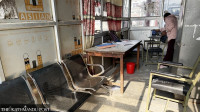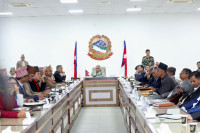National
Kerung and Tatopani border points set to reopen fully for trade, travel
Nepal-China mechanism in Lhasa agrees on Wednesday to reopen Kerung point from April 1 and Tatopani from May 1.
Post Report
Senior Nepali and Chinese officials have agreed to fully reopen the Kerung border point for two-way trade and movement of people from April 1. The decision was made on Wednesday during the first meeting of the Nepal-China Coordination Mechanism on Border Trade and Cooperation held in Lhasa on Wednesday.
The meeting was co-chaired by Madhu Kumar Marasini, secretary at the Ministry of Industry, Commerce and Supplies and Chen Yongqi, executive vice-chair of the People’s Government of the Tibet Autonomous Region of China.
Nepali officials have been complaining of repeated restrictions on the movement of goods and people by China at the Kerung border point since the onset of the Covid pandemic in early 2020. This has severely hurt bilateral trade.
The Chinese authorities shut both the border points—Rasuwagadhi/Kerung and Tatopani/Zhangmu—after China imposed a zero-Covid policy. After exports to China via the border points nosedived, Nepal has been repeatedly requesting the Chinese side to make the points fully operational.
“During the meeting, the two sides agreed to have full operation of Rasuwagadhi/Kerung exit and entry point for two-way trade and people-to-people movement from April 1, 2023. Similarly, two-way trade via Tatopani/Zhangmu and human movement/passenger clearance from Yari/Pulang will resume from May 1, 2023,” said a statement issued by the Consulate General of Nepal, Lhasa.
Upon Nepal’s request, the Chinese side has agreed to consider setting up a multi-functional lab on the Nepal-China border, the statement added.
Nepal had been asking China to set up such a laboratory so that Nepali products can be exported to China without any hindrances.
China also welcomed Nepal’s suggestion for the construction of a trans-border special economic zone and request for technical and financial support to build infrastructures on the Nepal side at the Nechung-Lizi border port, said the statement. The Nechung exit point is located in Mustang district.
Nepal and China had earlier agreed to open up six overland border points for bilateral trade. These include Kodari-Nyalam (Tatopani-Khasa), Rasuwa-Kerung, Yari (Humla)-Purang, Olangchunggola-Riwu, Kimathanka-Riwu and Nechung (Mustang)-Lizi, but only two have come into the operation while recently Yari in Humla has also opened.
The Chinese side has assured to open seasonal border trade points at Nepal-China border, said the statement.
“The discussion was focused on resuming cross-border trade and people to people movement at optimum level and exploring new avenues of cooperation in border trade and cooperation including smooth operation of land ports, trade facilitation, custom cooperation, border area development, trade-related infrastructures, among others,” reads the statement further.
Nepali traders, politicians and officials have been raising the issues of obstruction in bilateral trade with China since the Covid outbreak at the end of 2019. Bilateral trade is taking place only via the Rasuwagadhi-Kerung border.
While acknowledging the importance of closer economic and trade relations between the two countries, the two delegations exchanged views on possible cooperation on a range of areas including the export of agricultural and livestock products such as citrus fruits, dried meat and medicinal herbal products to China, said the statement.
This is the first meeting of the joint mechanism set up in August last year during the official visit of then foreign minister Narayan Khadka to Qingdao, China.
Secretary Marasini stressed the need for Kathmandu-Lhasa direct flights, and requested the Chinese side to resume them at the earliest.
“Both sides also underlined the need to enhance the level of support for improving the livelihoods of the people residing in bordering districts in the northern Himalayan region of Nepal,” reads the statement, adding, “The Chinese side also agreed to encourage its business community to invest in Nepal in different sectors like manufacturing, agriculture and garments.”
In light of the recent policies adopted by both the countries in response to Covid, the two sides agreed to rename the ‘Nepal-China Joint Epidemic Prevention and Control Mechanism’ as the ‘Nepal-China Coordination Mechanism on Border Trade and Cooperation’.
The Nepali delegation comprised senior officials from the Ministry of Foreign Affairs; Consulate General of Nepal in Lhasa; Ministry of Industry, Commerce and Supplies; Ministry of Finance; Ministry of Agriculture and Livestock Development. Likewise, the Chinese delegation included high-ranking officials of the Foreign Affairs Office of China’s Tibet Autonomous Region, the Department of Commerce, Customs, Exit-Entry, and the Department of Health.
Later in the afternoon, Marasini, the secretary at the Ministry of Industry, Commerce and Supplies, and the head of the Nepali delegation paid a courtesy call on Yan Jinghai, chairman of the People’s Government of the Tibet Autonomous Region of the People’s Republic of China.
During the meeting, views were exchanged on matters of mutual interest including the promotion of economic cooperation between Nepal and China in general and Nepal and the Tibet Autonomous Region of China in particular.




 18.12°C Kathmandu
18.12°C Kathmandu














